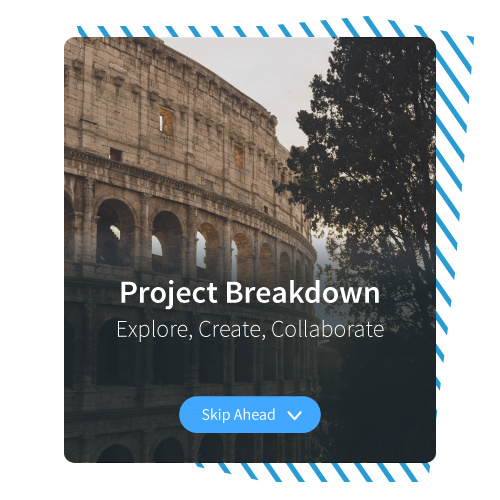Financial Literacy: My Dream Vacation
Who doesn’t love thinking about a dream vacation?
I wanted to share a recent project that I adapted from the Edwin Library. This project challenges students to ask in-depth questions, conduct research, and apply the mathematical skills necessary to make a clear plan for their dream vacation. With a strict budget, the choices become very important, and that’s what students love the most.
I have customized this Collection to adapt for Grades 6, 7, and 8 so that you can tweak it to meet the needs of your students. In this article, I share the project breakdown and the tools and resources that I used.
How I Customized “My Dream Vacation” Project
The “Big Idea”
Whenever I begin a new project with my students, I know I’ve got to deliver on the “Big Idea.” The why or the purpose of the project needs to be juicy and it needs to matter.
Student Prompt: What is your dream vacation? If you had one week to go anywhere, where would you go? What exciting activities would you do? In this project, you will apply your knowledge of mathematical operations with whole numbers and decimals, payment methods, and finances to plan a dream vacation. Where will your adventure take you?
Project Breakdown
The Leading Problem
Now that students are excited about the idea of planning their dream vacation, I wanted to build some hype around how they would choose their budget. Here, I used the Math Spinner tool inside Edwin so that students could have some fun randomly choosing their budget. It’s a lot of fun getting the whole class involved with this and building the anticipation with each spin.
You can customize the budget options inside the spinner. Here I have given 10 possible outcomes, but you can choose whatever number you like.
Planning Phase
We began by unpacking the questions we would need to ask to ensure we stayed within our vacation budget. To help students get into the right headspace, I gave them a few question examples from the Edwin resource and then encouraged them to come up with their own.
Student Prompt: Determine what you will need to know. What questions are missing from this list that you’ll need to consider when budgeting for your dream vacation? Add more questions to the list in your notes.
Collaborate With Your Peers
Next, I had students collaborate with one another using Google Jamboard. Google Jamboard is a tool that allows students to collaborate with their peers in real-time. Students can add images and create digital sticky notes as they create together.
Other collaboration tools to consider: Microsoft Whiteboard | PearDeck | WeVideo | Explain Everything
Student Prompt: Go to Dream Vacation Jamboard and add two of your own questions. Do your best to group your questions with similar ones.
Inquiry: Gather Information
The last stage of the planning phase was a guided inquiry process. I had students use the 4 Learning Objects in the Collection to begin gathering the information and tools needed to answer their original questions. Then, I had them communicate a clear solution to ensure their dream vacation met their end budget.
Student Prompt: What do I need to know to begin answering these questions? Students can explore the Collection to find helpful information and examples in the Edwin Learning Objects like:
Assessment Tools
Now, there are a number of ways that I could have assessed this project. I knew I wanted students to effectively communicate their understanding and provide a clear rationale for the decisions they made. I decided to have students submit their Edwin Collections with all of their notes and plans inside. I used the rubric provided to assess their process. I wanted to keep the end product flexible so that students could be creative.
Possible Extension
Have students create a Blog post using Google Sites where they can showcase their entire trip itinerary. You could also encourage students to consider the economic and cultural impact of their vacation and include this in their blog. There are so many ways to pull in multiple subject areas.
FYI, there are great resources on how to create Blog Posts in Edwin:
Explore more:
Inside Edwin, you will find many more resources to support Financial Literacy. Click the images below to see for yourself:
This interactive shows you how percents are calculated and also guides you through the process of doing it yourself.
Use a cupcake recipe to estimate the costs of running a cupcake business to reach a financial goal of $1000. You will estimate the cost of baking the cupcakes, estimate the profit, and compare the profit rate to the goal.
Explore accounts and different financial institutions. Then, review two worked questions that show you how to read and check a bank statement, and compare simple interest options.
Percent and Financial Literacy
Explore how percent is used in sales and taxes. Then, review three worked examples that show you how to determine the total cost of a regular-priced item, the total cost for a sale item, and combined percent discounts.
Not on Edwin yet?
Explore these topics and more in your classroom with an Edwin FREE Trial:
Claire Varley, M. Ed (elementary), OCT, Senior Team Lead, Edwin Classroom Success at Nelson
Claire graduated with a bachelor’s degree in the Humanities, which she followed up with post-graduate work in Education. Claire spent many years in the classroom at both the primary and junior level with the majority of her time spent at the Grade 3 and 6 levels. In the classroom, she concentrated her professional learning around effectively teaching both literacy and numeracy. Claire then began working in educational publishing where she's held a management role at Nelson for the past 2 years.















